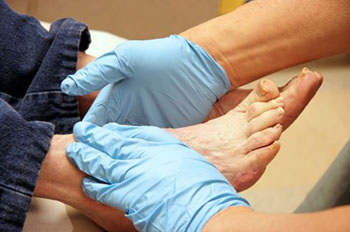Comprehensive Diabetic Foot Exam
THE COMPREHENSIVE DIABETIC FOOT EXAM (CDFE)
 People with diabetes can develop many different foot problems. Even ordinary problems can get worse and lead to serious complications. Foot problems most often happen when there is nerve damage, also called neuropathy, which results in loss of feeling in your feet. Poor blood flow or changes in the shape of your feet or toes may also cause problems. It is for this reason that the American Diabetes Association among others recommends that your healthcare provider perform a Comprehensive Diabetic Foot Exam (CDFE) up to four times a year.
People with diabetes can develop many different foot problems. Even ordinary problems can get worse and lead to serious complications. Foot problems most often happen when there is nerve damage, also called neuropathy, which results in loss of feeling in your feet. Poor blood flow or changes in the shape of your feet or toes may also cause problems. It is for this reason that the American Diabetes Association among others recommends that your healthcare provider perform a Comprehensive Diabetic Foot Exam (CDFE) up to four times a year.
WHAT IS A COMPREHENSIVE DIABETIC FOOT EXAM (CDFE)?
A CDFE is a comprehensive lower extremity physical examination combined with an educational and counseling session performed on people with diabetes. Your healthcare provider should perform a CDFE at lease annually - more often if you have foot problems. During this exam, your healthcare provider will check your feet for signs of pressure or friction, calluses, nail problems, red spots, and signs of infection. They will also evaluate the condition of your skin. The exam will include non-invasive tests to see if you have lost any feeling in your feet a simple examination of your circulation and if there is any change in the shape of your feet. The exam may turn up nothing, which means that your feet are in good condition. If changes are noted early, preventative measures can be taken. The CDFE concludes with an educational session to inform you about your specific risk factors and counseling on proper foot care.
WHY IS IT SO IMPORTANT?
Nerve damage, poor circulation, and trouble fighting infections can make foot problems serious for people with diabetes. Nerve damage makes the skin and nails susceptible to injury. Healing is often slowed down or more difficult for people with diabetes. Skin breakdown can lead to chronic foot ulcers (long standing sores). The goal of the CDFE is to find any changes in your feet as early as possible. In most cases, proper care of your feet can prevent ulcers and the risk of amputation.




